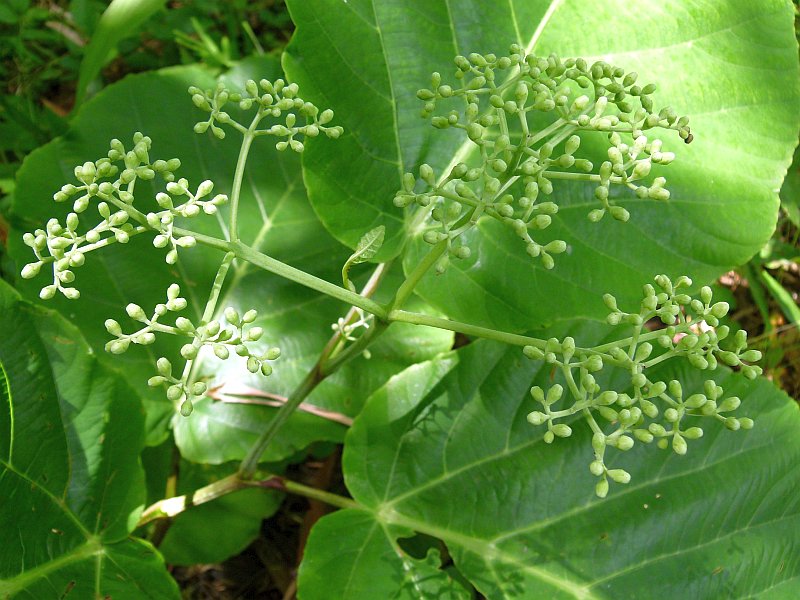Hastikarna/Leea macrophylla - Health benefits, application, chemical constituents, side effects and many more
Hastikarna/Leea macrophylla
Hastikarna/Leea contains approximately 36 species and is placed in its monogeneric family Leeaceae. Out of the 36 species, India has 11 species distributed in different states, as mentioned in the database of the Botanical Survey of India. Various studies of different species of this genus recorded varied pharmacological actions like antimicrobial, anti-oxidant, anticancer and nephroprotective effects. Root and leaf of Leea macrophylla contain vitamins like thiamine, riboflavin and ascorbic acid along with vitamin B12.
Garuda purana (1500 BC– 300 BC), in a separate chapter, has described the rasayana properties of Hastikarnapalasha11. This shows the importance of the drug at that point of time. In Samhita period (2000 B.C.-1300A.D.), Sushruta samhita (1000 B.C- 2th A.D) has quoted Hastikarna in Sanshodhanashamaneeya adhyaya (Su. S. Sutra 39/9) under Kaphasanshaman dravya10; in Dravadravyavidhiradhyaya (Su. S. Sutra 45/115),; In Shwayathu chikitsadhyaya (A. Hr. 17/27) of Ashtanga Hridaya (7th century A.D.), Vagbhata has advised Sukhoshna kalka lepa (Local application of tolerable hot paste) prepared from leaves of Hastikarna and other drugs in Ekanga shotha.
Click here for more information about Antioxidant and Free radicals
It has different names in different languages such as English Na...............read more
Part Used
Roots, Tubers, leaves, Seeds
Phytochemical constituents
• The leaves contain an abundance of of phenolic constituents such as flavonoids, leucoanthocyanidins, p-hydroxybenzoic acid, syringic acid and gallic acid.
• It is one of the most important species of genus Leea in India, and different parts are reported to show the presence of known chemical compounds, including 11 hydrocarbons, phthalic acid, palmitic acid, 1-eicosanol, solanesol, fa...............read more.
Properties and Benefits
- Taste – bitter
- Potency (virya) – hot
- Taste conversion after digestion (vipaka) – sweet
- Shitajwara – fever with cold and chills
- Effect on Tridoshas : Balances vata and kapha dosha
- Click here for more information about Tridosha(vata-Kapha-Pitta)
Gajakarna Tubers
- Vikashi – produces looseness of joints
- Taste conversion after digestion (vipaka) – sweet
- Sangrahi – Absorbent, can be used in diarrhea
- Effect on Tridoshas – balances vata and pitta dosha
- Pandu – anemia
- Shotha – swelling and inflammation
- Krimi – intestinal worm infestation
- Pliha – spleenomegaly
- Gulma – abdominal tumor
- Aanaha – fullness of abd...............read more
Uses, Remedies, Benefits and Application
1) Leea macrophylla can be used in Food. Leaves are cooked as vegetable and mature fruits are eaten raw.
2) For birth control – Hastikarn root paste is consumed with a glass of milk every month as a single dose.
Click here for more information about Milk
3) Male sexual debility – the powdered tuber is used. Root powder is taken once a day for 7 days.
4) Wounds, Sores, Guinea worm, Ringworm – the roots are made paste and applied externally as a poultice.
5) Inflammation – Leaf juice is used externally in boils, arthritis, gout and rheumatism. It is considered as a good local anti inflammatory agent.
6) Anti aging – Dried root powder is mixed with clarified butter and consumed in the morning.
7) Pain, Paralysis – Crushed leaves and roots are mixed with oil and applied externally to relieve body pain and paralysis.
Click here for more information about Sesame Oil
8) (Traditional) Typhoid – Stems and roots of this plant are made into a paste with leaves of Kalanchoe pinnata. It is taken in the dose of ¼ teaspoonful with 1 teaspoon honey thrice daily for 7 days. If it is not cured than it is taken for another 7 days.
Click here for more information about Honey
9) To expel intestinal worm – root infusion is consumed.
10) Skin diseases – root paste is applied externally.
11) To increase the sperm count – Small cut pieces of roots are soaked in water for 4–5 hours and its mucilaginous extract is consumed.
12) Jaundice – Root paste or powder is used to treat jaundice.
13) Rheumatic pain – crushed roots are applied to the effected areas.
14) Kidney problems – root paste is consumed with milk.
15) The leaves have been usedin goitre, gastric tumor, lipoma, an...............read more
Further read on following link
https://kbjawadwar.blogspot.com/2022/01/hastikarnaleea-macrophylla-health.html
If you want to give more suggestion in this, then comment us, we will replay your comment.
If you like this post, then share it and follow us on Instagram (@healthyeats793) and many thanks for coming to our site Healthy eats
keep visiting
Follow us
2) Facebook
3) Pinterest
🙏🙏Subscribe and share for latest updates 🙏🙏
More posts from our site
- Click here for more information about Tamarind
- Click here for more information about Nutmeg (Jaiphal)
- Click here for more information about Viruddha aahra
- Click here for more information about Bay leaves
- Click here for more information about Jambul (java phalam)
- Click here for more information about Marking nut (bibba)
- Click here for more Home remedies of Nirgundi
- Click here for more information about saffron
- Click here for more information about Neem
Refrence :
- Sarvada D.D. and Acharya R.N. 2019 Greentree Group Publishers © IJAPCInt J Ayu Pharm Chem 2019 Vol. 11 Issue 1 [e ISSN 2350-0204]
- Kaiyadeva Nighantu
- Bhavaprakasha nighantu
- Sushruta samhita
- European Journal of Medical and Health Sciences, 3(3), 58-61, 2021
- Ashtanga Hriday
- IJPSR (2021), Volume 12, Issue 5
- Raja nighantu
- Dravyaguna vigyana
- International Journal of Green Pharmacy • Jan-Mar 2019 • 13 (1) | 13
- NCBI & PUBMED





Comments
Post a Comment